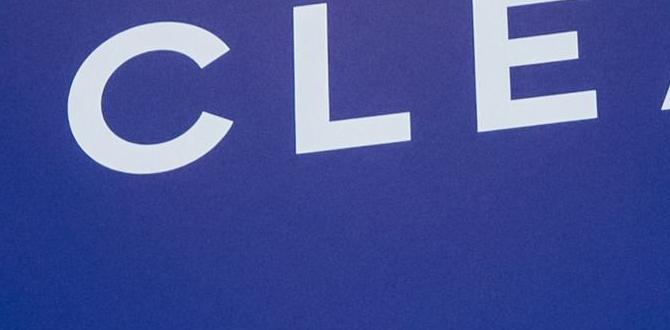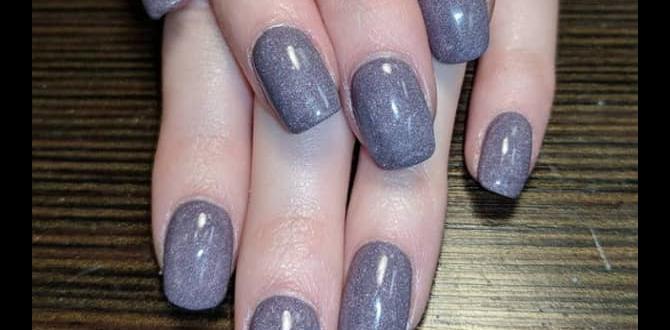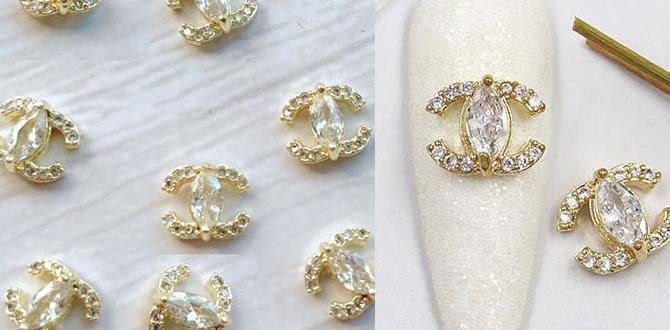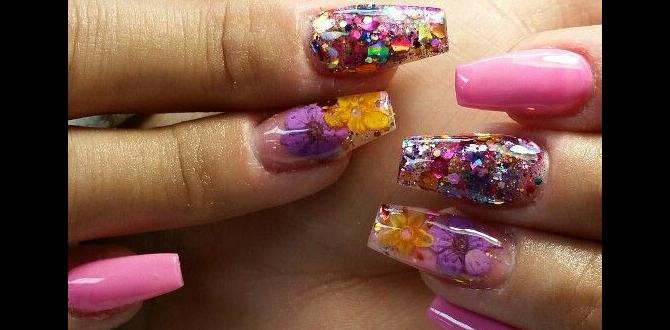Looking for beautiful nail art without the harsh chemicals? Toxin-free nail designs focus on healthier polish options and mindful application, letting you express your style safely. Discover easy ways to achieve stunning, guilt-free manicures that are good for you and the planet.
Are you dreaming of gorgeous nails but worried about the ingredients in traditional polishes? You’re not alone! Many of us love the feeling of a fresh manicure, but the thought of harsh chemicals can dim the sparkle. It’s a common concern, and finding safe, beautiful alternatives feels like a puzzle. But what if I told you that stunning nail designs and essential nail care can go hand-in-hand with healthier practices? Get ready to learn how you can achieve fabulous, toxin-free nail designs that you’ll love, all while being kind to yourself. We’ll explore simple steps and easy-to-find products that make toxin-free beauty totally achievable!
Nailerguy is here to make your nail journey a breeze. We believe everyone deserves to feel confident and creative with their look, and that includes your nails! From choosing the right polish to creating eye-catching designs, we’re all about making nail art fun, simple, and accessible for everyone. So, let’s dive into the wonderful world of toxin-free nail designs and unlock a more beautiful, healthy you!
Why Choose Toxin-Free Nail Designs?
Making the switch to toxin-free nail designs isn’t just a trend; it’s a smart choice for your well-being and the environment. Traditional nail polishes often contain a cocktail of chemicals that can be concerning. “The ‘big three’ chemicals to watch out for in nail polish are formaldehyde, toluene, and dibutyl phthalate (DBP),” explains the U.S. Food & Drug Administration (FDA). These can be linked to health issues for both the user and the nail salon professionals who are exposed regularly. By opting for “3-free,” “5-free,” “7-free,” “10-free,” or even “15-free” polishes, you’re significantly reducing your exposure to these potentially harmful substances. This means you can enjoy beautiful nails without the worry. It’s about indulging in self-care that aligns with a healthier lifestyle.
Key Chemicals to Avoid and Why
Let’s break down some of the common culprits found in conventional nail polishes and why you might want to steer clear:
- Formaldehyde: Often used as a preservative, it can also harden polish. However, it’s a known carcinogen and can cause allergic reactions and respiratory problems.
- Toluene: This solvent helps create a smooth finish. It can affect your nervous system and cause headaches, dizziness, and skin irritation.
- Dibutyl Phthalate (DBP): A plasticizer that makes polish flexible. It’s linked to reproductive and developmental issues.
- Formaldehyde Resin: A formaldehyde derivative used for gloss and durability, it can also cause allergic reactions.
- Camphor: Used to prevent chipping, it can cause nausea and allergic reactions.
- Xylene: Another solvent that can cause headaches and dizziness.
- Parabens: Preservatives that can disrupt hormones.
Many brands now offer polishes formulated without these and other questionable ingredients. Looking for labels like “3-Free,” “5-Free,” “7-Free,” “10-Free,” or “15-Free” is a great starting point. The higher the number, the more chemicals the formula is free from!
What Does “X-Free” Really Mean?
You’ll see a lot of “X-Free” claims on nail polish bottles. Here’s a quick guide to what they generally signify:
| Label | Commonly Excluded Chemicals |
|---|---|
| 3-Free | Formaldehyde, Toluene, DBP (Dibutyl Phthalate) |
| 5-Free | Formaldehyde, Toluene, DBP, Formaldehyde Resin, Camphor |
| 7-Free | Formaldehyde, Toluene, DBP, Formaldehyde Resin, Camphor, Xylene, Parabens |
| 10-Free | The above, plus Ethyl Tosylamide, Triphenyl Phosphate (TPHP), and Xylene |
| 15-Free | Even fewer ingredients, often including additional common allergens and toxins. Specific exclusions vary by brand. |
It’s always a good idea to check the brand’s specific ingredient list if you have particular concerns. Some brands are even moving towards “21-free” or “clean” formulations, offering even more peace of mind!
Easy Toxin-Free Nail Designs for Beginners
Ready to get creative? Toxin-free nail design doesn’t mean sacrificing style. In fact, many of the most chic looks are surprisingly simple to achieve at home. We’ll focus on techniques that are forgiving and don’t require professional tools.
DIY Minimalist Dots
This is an absolute classic and perfect for beginners. Dots are versatile and can be styled in so many ways!
What You’ll Need:
- Your favorite 5-free or 7-free nail polish (base color)
- A contrasting color 5-free or 7-free nail polish
- A dotting tool (or a toothpick/ballpoint pen tip)
- A good quality, quick-dry top coat
Steps:
- Prep Your Nails: Start with clean, dry nails. Apply a thin layer of your base polish and let it dry completely. This is crucial for a smooth finish.
- Load Your Tool: Dip the tip of your dotting tool (or toothpick) into the contrasting polish. You don’t need a huge blob; a small amount is perfect.
- Create Your Dots: Gently touch the tip of the tool to your nail to leave a perfectly rounded dot. You can place them anywhere – a single dot at the base of the nail, a line of dots down the center, or scattered randomly.
- Experiment with Placement: Try a single bold dot on each nail, or create a pattern like polka dots. For a modern look, try scattering smaller dots of varying sizes.
- Repeat: Continue adding dots until you’re happy with your design. Clean your dotting tool with nail polish remover after each color or cluster of dots to keep your lines clean.
- Seal the Deal: Once your dots are completely dry, apply a layer of your toxin-free quick-dry top coat to seal the design and add shine.
The Chic French Tip Upgrade
The French manicure is timeless, and a toxin-free version is just as elegant. Here’s how to give it a modern twist.
What You’ll Need:
- A sheer nude or pale pink 5-free or 7-free polish (base)
- A white or pastel 5-free or 7-free polish (tip color)
- Optional: Guide strips for French tips (you can find these at beauty stores)
- A quick-dry top coat
Steps:
- Apply Base: Paint your nails with the sheer nude or pale pink polish. Let it dry thoroughly. This provides a clean canvas.
- Create the Tips:
- With Guide Strips: Carefully apply the guide strips near the tips of your nails, creating a curve where you want your white tip to start. Paint over the exposed tip with your white or pastel polish. Peel off the strips while the polish is still slightly wet to avoid any jagged edges.
- Freehand: For a more organic look, use a fine-tipped brush or the polish wand to carefully draw a line across the tip of your nail, then fill it in. Aim for a natural curve.
- Add a Pop (Optional): For a modern look, try a colored French tip! Instead of white, use a bright coral, a soft lavender, or a metallic shade.
- Seal It: Once the tips are completely dry, apply a generous layer of your favorite toxin-free top coat.
Simple Gradient (Ombre) Effect
This look might seem complicated, but it’s surprisingly easy and creates a beautiful, seamless blend of colors.
What You’ll Need:
- Two or three complementary shades of 5-free or 7-free nail polish (e.g., light pink to deeper pink, or peach to coral)
- A makeup sponge (a clean, textured one works best)
- A base coat
- A top coat
- Optional: Petroleum jelly or liquid latex for easy cleanup around the cuticles
Steps:
- Prep: Apply your base coat and let it dry. If using petroleum jelly or liquid latex, apply a thin layer around your nails to catch any excess polish.
- Apply Colors to Sponge: Paint stripes of your chosen colors directly onto the makeup sponge. Start with your lightest color at the top and blend into the next color. If using three colors, place them side-by-side.
- Stamp Onto Nail: Gently press the sponge onto your nail, rocking it slightly from side to side to help the colors blend. You might need to reapply polish to the sponge and stamp a couple of times to achieve your desired opacity.
- Clean Up: Carefully remove the guide you applied around your nail. Use a small brush dipped in nail polish remover to clean up any stray marks.
- Repeat for Other Nails: You may need to reapply polish to the sponge for each nail.
- Smooth and Seal: Once the gradient is dry, apply a thick layer of top coat. This will help meld the colors together and give your gradient a smooth, polished finish.
Essential Tools for Toxin-Free Nail Art
Having the right tools can make all the difference when creating toxin-free nail designs. You don’t need a professional kit to achieve salon-worthy looks; a few key items will get you started.
| Tool | Why It’s Essential | Tips for Toxin-Free Use |
|---|---|---|
| 5-Free/7-Free/10-Free Nail Polishes | The foundation of your healthy manicure. These polishes are formulated without common toxins. | Choose brands with clean ingredient lists and look for certifications if available. |
| Base Coat | Protects your natural nail from staining and helps polish adhere better for a longer-lasting manicure. | Ensure your base coat is also free from harsh chemicals. |
| Top Coat | Seals your design, adds shine, and prevents chipping. A quick-dry formula is a lifesaver! | Look for a quick-dry, high-shine top coat. Some even offer UV protection. |
| Dotting Tools | Perfect for creating precise dots, swirls, and small details. They come in various tip sizes for different effects. | Start with a set that includes a few sizes. You can also use a toothpick or the tip of a ballpoint pen in a pinch! |
| Fine-Tipped Brush | Great for drawing thin lines, creating French tips, or cleaning up edges. | You can find inexpensive makeup brushes or art brushes that work well. Ensure they are clean. |
| Nail Polish Remover (Acetone-Free) | Essential for cleaning up mistakes and removing polish. Acetone can be very drying. | Opt for an acetone-free formula, ideally infused with nourishing oils like vitamin E or jojoba. |
| Cuticle Oil | Keeps your cuticles hydrated and healthy, which is crucial for a polished look. Hydrated cuticles also help your manicure last longer. | Look for natural oils like jojoba, almond, or vitamin E. |
Caring for Your Nails Between Designs
Healthy nails are happy nails, and they provide the perfect canvas for any toxin-free design. Regular care ensures your nails are strong, smooth, and ready for their next polish adventure.
Hydration is Key
Just like your skin, your nails and cuticles need moisture. Dry, brittle nails are more prone to breaking and peeling, making them difficult to work with. Regularly applying a good cuticle oil is a simple step with big benefits.
- When to Apply: Gently massage cuticle oil into your nails and surrounding skin daily, especially before bed.
- Benefits: It keeps cuticles soft and prevents hangnails, promotes healthy nail growth, and adds a subtle shine.
Gentle Filing Techniques
How you file your nails matters! Vigorous sawing motions can weaken the nail and cause splitting. Always file in one direction.
- Tool: Use a fine-grit emery board or a glass nail file. Glass files are excellent because they seal the nail edge as you file, preventing future splitting.
- Direction: File from the side of the nail towards the center in a single, smooth stroke. Repeat on the other side.
- Shape: Choose a shape that suits your nail length and lifestyle. Oval or squoval shapes tend to be less prone to snagging than sharp square angles.
For more information on nail care, the American Academy of Dermatology Association offers excellent resources on maintaining healthy nails.
The Power of a Good Base Coat
Don’t skip this step! A quality base coat does more than just prevent staining. It creates a smooth, even surface for your polish to adhere to, which can significantly extend the life of your manicure.
- Protection: It acts as a barrier between your natural nail and the colored polish.
- Smoothness: It fills in minor ridges and imperfections on the nail surface.
- Adhesion: It provides a slightly tacky surface for your colored polish to grip, reducing the likelihood of chipping.
Toxin-Free Nail Polish Brands to Explore
Discovering great “X-Free” brands is part of the fun! Many brands are committed to providing beautiful, high-performance polishes without the harsh chemicals. Here are a few popular and highly-rated options to get you started:
- Zoya: A pioneer in the “healthy polish” movement, Zoya is 10-free and offers an extensive range of colors and finishes. They are known for their long wear.
- Ella+Mila: These polishes are 17-free, vegan, and cruelty-free. They have adorable names and a great selection of trendy shades.
- Butter London: A well-regarded brand that is 10-free. They offer high-quality formulas with excellent color payoff.
- Pacifica: Known for their wide range of clean beauty products, Pacifica offers 7-free, vegan, and cruelty-free nail polishes that are also budget-friendly.
- côte: This brand is 10-free and prides itself on its extensive “color archive.” They focus on non-toxic, high-shine formulas.
Always check the brand’s website for their most up-to-date ingredient information, as formulations can evolve.
Frequently Asked Questions About Toxin-Free Nail Designs
I know you might have some questions as you explore the world of toxin-free beauty! Here are some common ones:
Q1: Are “X-Free” nail polishes as durable as traditional ones?
A: Many “X-Free” polishes now perform just as well, if not better, than traditional formulas. Advances in clean beauty have led to formulas that are long-lasting and chip-resistant. Using a good base and top coat is still key for maximum durability, no matter the formula!
Q2: Where can I find acetone-free nail polish remover?
A: Acetone-free removers are widely available! You can find them at most drugstores, beauty supply stores, and online retailers. Brands like Zoya Renew, Ella+Mila




